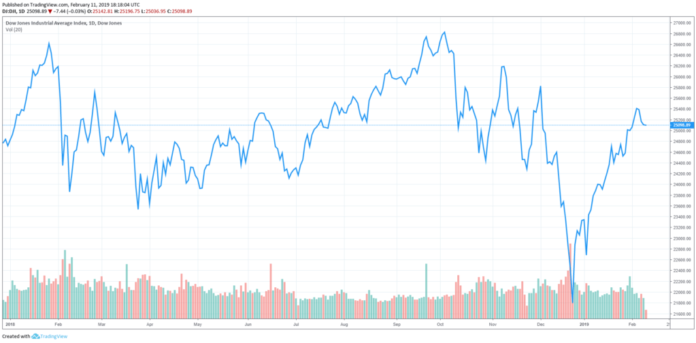[ad_1]
Throughout the past two weeks, analysts have generally attributed the recovery of Dow Jones to technical factors, expressing skepticism toward the sustainability of the U.S. stock market rally.
This week, Shawn Cruz, a trader strategy manager at $30 billion brokerage giant TD Ameritrade, said that the sentiment in the U.S. stock market has improved, especially among fundamental-based investors.
“[Indicators of economic stability are] giving the more fundamental-based investors faith coming back into the market, which is then driving what technical traders are seeing on their screen,” Cruz said, speaking to The Wall Street Journal.
Can the Dow Jones Rally?
Since December 24, the Dow Jones has initiated one of the most impressive turnarounds in recent years, recovering from 21,782.2 points to 25,411.52 points within less than two months.
The Dow has assembled a massive recovery since its late-December lows, but it might not continue through to a new all-time high.
The Dow Jones was at risk of entering a bear market in mid-December after the Nasdaq Composite recorded a 20 percent drop from its all-time high and officially obtained a bear market status.
The rapid growth of the Dow Jones in the past two months has led investors to question the factors of the movement of the U.S. stock market.
Apart from technical factors, most fundamental factors such as geopolitical risks and weak earnings reports from major conglomerates in the U.S. remain as the core issues for investors.
On February 4, CCN reported that Raymond Jones fixed income capital markets head Kevin Giddis said the U.S. market lacks stimulus to grow in the upcoming months.
“There is obviously a separation between where the equity market sees the world and where the bond market sees the world. We don’t know what’ll cause the next recession, but at the same time, you flip it to the other side and you don’t see much that’ll stimulate economic growth.”
In the last seven days, the Dow Jones has retraced from 25,411.52 points to 25,045.96. Currently, the Dow is at risk of falling below the 25,000 level.
To sustain the positive trend of the U.S. stock market in recent weeks, Direxion Investments managing director Paul Brigandi said that it is crucial for the market to maintain its momentum.
Many investors are trading based on sentiment and are allocating capital into the stock market again as major indexes began to recover.
“Momentum is a key component right now. A lot of people are jumping in to get on board,” he said.
Investors Have to Consider Short-Term Stock Market Risks
Some analysts foresee a continuous rally for the Dow Jones. But, others including Morgan Stanley senior portfolio manager Andrew Slimmon fear for the weak corporate earnings released in the past 30 days.
Apart from the oil industry, which outperformed the expectations of Wall Street following a decline in the price of oil, most major industries have struggled.
The financial sector has performed especially poorly in the fourth quarter with most banks cutting back on their projected revenues.
Slimmon said:
“I’m worried. As much as companies look like they made fourth-quarter numbers, the 2019 estimates are dropping, and it strengthens my concern.”
With weak corporate earnings, no significant development in the U.S.-China trade talks, and the declining euro-zone economy, the U.S. market may be at risk of experiencing a short-term trend reversal.
As emphasized by TD Ameritrade strategist Shawn Cruz and Direcixion investments executive Paul Brigandi, momentum is crucial for the U.S. stock market.
If the Dow Jones fails to sustain stability above the 25,000 level, a risk of a further decline could intensify and drastically alter the current sentiment in the market which remains positive to this date.
In the short-term, large volatility in the U.S. market is expected, but analysts remain uncertain whether that could mean a rally to bounce back from this week’s losses or a further drop to December levels.
Featured Image from Shutterstock
[ad_2]
Source link
